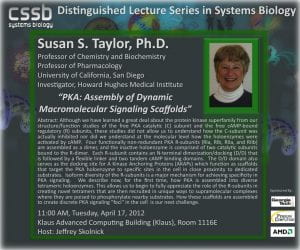 Distinguished Lecture Series Guest Speaker: Susan S. Taylor
Distinguished Lecture Series Guest Speaker: Susan S. Taylor
Professor of Chemistry and Biochemistry
Professor of Pharmacology
University of California, San Diego
Investigator, Howard Hughes Medical Institute
Date & Time: Tuesday, April 17, 2012, 11:00AM
Location: Klaus 1116E
Host: Jeffrey Skolnick
Abstract: Although we have learned a great deal about the protein kinase superfamily from our structure/function studies of the free PKA catalytic (C) subunit and the free cAMP-bound regulatory (R) subunits, these studies did not allow us to understand how the C-subunit was actually inhibited nor did we understand at the molecular level how the holoenzymes were activated by cAMP. Four functionally non-redundant PKA R-subunits (RIa, RIb, RIIa, and RIIb) are assembled as a dimer, and the inactive holoenzyme is comprised of two catalytic subunits bound to the R-dimer. Each R-subunit contains an N-terminal dimerization/docking (D/D) that is followed by a flexible linker and two tandem cAMP binding domains. The D/D domain also serves as the docking site for A Kinase Anchoring Proteins (AKAPs) which function as scaffolds that target the PKA holoenzyme to specific sites in the cell in close proximity to dedicated substrates. Isoform diversity of the R-subunits is a major mechanism for achieving specificity in PKA signaling. We describe now, for the first time, how PKA is assembled into diverse tetrameric holoenzymes. This allows us to begin to fully appreciate the role of the R-subunits in creating novel tetramers that are then recruited in unique ways to supramolecular complexes where they are poised to phosphorylate nearby substrates. How these scaffolds are assembled to create discrete PKA signaling “foci” in the cell is our next challenge.
Additional Info: Dr. Taylor’s lab is studying the structure, dynamics, and localization of cAMP-dependent protein kinase. PKA is a prototype for the protein kinase superfamily involved in signal transduction. They are working to understand the dynamic behavior of PKA and other proteins associated with it. In addition to understanding the behaviors of these proteins, they are trying to find how the structure and dynamics are changed when associated with a large molecular assembly.
